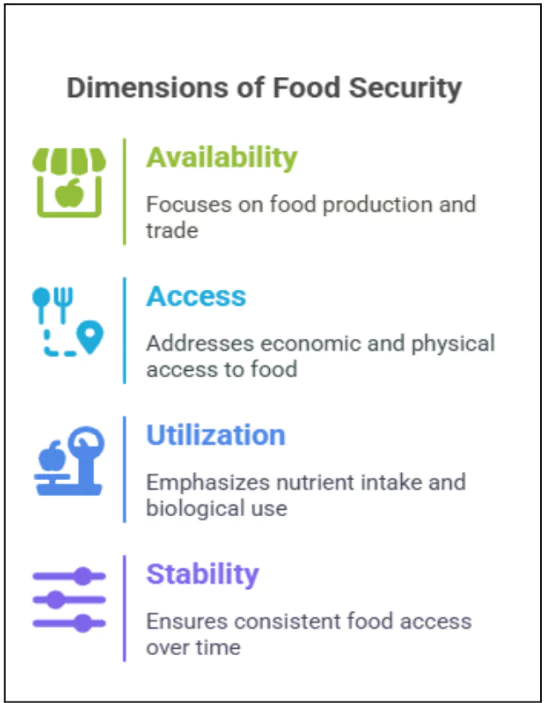In 2024, over 295 million people across 53 countries faced acute hunger, marking a grim rise in global food insecurity for the sixth consecutive year.
Key Findings of the Global Report on Food Crises 2025
- Worsening Hunger Worldwide: The number of acutely food-insecure people rose by 13.7 million in one year, reaching 295 million in 2024.
- Catastrophic Hunger Doubled: Nearly 1.9 million people faced catastrophic food insecurity (IPC Phase 5), more than double the 2023 figure and the highest since 2016.
- Children Severely Affected: Approximately 38 million children under five suffered from acute malnutrition, with alarming levels in Gaza, Mali, Sudan, and Yemen.
Global Report on Food Crises (GRFC)
- The Global Report on Food Crises is an annual report that provides a comprehensive analysis of acute food insecurity around the world.
- Published By: It is jointly published by the Global Network Against Food Crises (GNAFC), which includes organizations like the European Union, FAO, WFP, and others.
- Purpose: To inform humanitarian and development responses by identifying the severity, causes, and geographic spread of food crises.
- Scope: It focuses specifically on populations facing acute food insecurity, rather than chronic or hidden hunger.
- Significance: It helps coordinate global efforts to prevent famine, address root causes of food crises, and guide resource allocation and policymaking for food security
|
- Conflict Remains the Top Driver: Around 140 million people in 20 countries experienced hunger due to violent conflict and instability.
- Factors Intensifying Crisis: Forced displacement and climate extremes like El Niño-induced droughts pushed millions further into crisis.
About Hunger, Food Crisis and Global Targets
- Hunger, as defined by the FAO, refers to the regular intake of insufficient calories, failing to meet the body’s minimum dietary energy needs.
 It causes physical discomfort and reflects deeper poverty-related issues.
It causes physical discomfort and reflects deeper poverty-related issues.
- Types of Hunger:
- Acute Hunger is a severe form of undernourishment that occurs over a short period, often triggered by emergencies such as conflicts, natural disasters, or climate shocks like El Niño.
- Chronic Hunger is a long-term condition where individuals consistently consume less food than needed, typically due to persistent poverty and limited access to nutritious food.
- Hidden Hunger is a form of chronic undernourishment caused by a deficiency of vital micronutrients like vitamin A, iron, iodine, or zinc, often without visible symptoms but with serious health consequences.
- Acute Food Insecurity: According to the report, acute food insecurity occurs when one or more dimensions of food security such as availability, access, utilisation, and stability are severely compromised due to external shocks such as erratic monsoon.
- Food Crisis: A food crisis is declared when hunger levels exceed a country’s capacity to respond and require urgent action to save lives and livelihoods.
- Zero Hunger by 2030: The United Nations’ Sustainable Development Goal 2 aims to end hunger, achieve food security, improve nutrition, and promote sustainable agriculture globally by 2030.
Major Global Initiatives to Address Hunger
- FAO: Under the Hand-in-Hand Initiative, FAO targeted 20 low-income countries with urgent food system reforms and climate-resilient agriculture, including digital agritech solutions in Africa.
- UNICEF : In 2024, UNICEF scaled its No Time to Waste strategy to reach 7 million malnourished children to address the alarming rise in hunger.
- World Food Programme: WFP is the world’s largest humanitarian Organization providing assistance to 152 Million people in 2023.
- WFP’s School Meals Coalition restored school feeding in post-COVID zones like Ethiopia and Haiti.
- World Bank: Through the Crisis Response Window – Early Response Financing, the Bank committed over $1 billion in 2024 to fragile states like Yemen and Somalia to rebuild food systems and provide cash transfers.
Challenges in Addressing Global Hunger
- Conflict and Political Instability: War and insurgency in regions like Sudan, Gaza, and Haiti continue to obstruct food access and agricultural activity.
- Climate Extremes: Droughts, floods, and rising temperatures exacerbated by El Niño caused widespread crop failures, especially in southern Africa.
- Economic Shocks: Inflation and currency collapse drove hunger in 15 countries, impacting 59.4 million people, nearly double pre-pandemic levels.
- Forced Displacement: Out of 128 million forcibly displaced people globally, over 95 million were living in hunger-affected countries.
- Funding Shortfall: A projected 45% drop in humanitarian aid for food crises in 2025 threatens nutrition services for at least 14 million children.
Way Forward
- Evidence-Based Interventions: Responses must be driven by data, focusing on scalable solutions that deliver measurable outcomes.
- Investing in Local Food Systems: Strengthening indigenous agriculture and decentralised supply chains will reduce dependency on imports and external aid.
- Integrated Nutrition Services: Governments and NGOs should converge health, sanitation, and food services to combat malnutrition sustainably.
- Protecting the Most Vulnerable: Children, displaced populations, and conflict-affected communities must remain central to global food security strategies.
- Global Cooperation and Accountability: Urgent, unified international action is needed to meet SDG 2 targets and build a hunger-free world.
![]() 17 May 2025
17 May 2025

 It causes physical discomfort and reflects deeper poverty-related issues.
It causes physical discomfort and reflects deeper poverty-related issues.